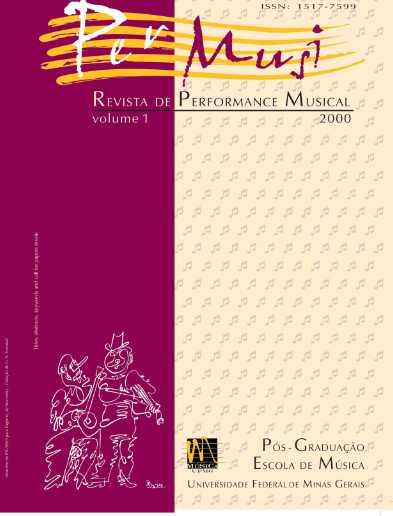Performance instrumental e educação musical
a relação entre a compreensão musical e a técnica
Palavras-chave:
Compreensão musical, Técnica musical, Performance musical, Educação musicalResumo
A observação da produção musical dos alunos através das modalidades de composição, apreciação e performance permite clarear a natureza da relação entre a técnica e a compreensão musical. Sugere-se que a manifestação do nível ótimo de compreensão musical depende do refinamento técnico necessário para se realizar diferentes atividades. Os resultados confirmam esta hipótese, revelando que a performance instrumental pode ser o indicador menos apropriado da compreensão musical dos alunos devido à complexidade desta modalidade. A continuidade deste estudo está sendo conduzida tendo em vista as implicações da escolha do repertório para o desenvolvimento musical dos alunos.
Referências
AGUIAR, Ernani. Canto da Suite Quatro Momentos no. 3. CD Orquestra Brasil Folclore. Microservice, NM 44796, 1996.
BACH, J.S. Notenbüchlen für Anna Magdalena Bach. Munchen: Henle, 1725.
COOLICAN, Hugh. Research Methods and Statistics in Psychology. London: Hodder & Stoughton, 1994.
COPE, Peter e SMITH, Hugh. Cultural context in musical instrument learning. British Journal of Music Education, v.14, n.3, p.283-289. Cambridge: Cambridge University Press, 1997.
GNATTALLI, Radamés. Remechendo [sic]. CD Minasax Quarteto de Saxophones . Microserve, MS – CD97/001,1997.
HARGREAVES, David. The developmental psychology of music: Scope and aims. In: G. SPRUCE (Ed). Teaching Music. London: Routledge, 1996.
HENTSCHKE, Liane. Musical development: testing a model in the audience-listening setting. Tese de Doutorado, PhD, University of London Institute of Education,1993.
JOBIM, Tom e OLIVEIRA, Aluísio. Dindi. CD The best of Antonio C. Jobim. Sonopress, BS-204, 1990.
KABALEVSKY, Dimitri. 24 Pequeñas Piezas, op.39. Buenos Aires: Ricordi, 1948.
LAVILLE, Christian e DIONNE, Jean.A Construção do Saber. Porto Alegre: Editora UFMG/Artmed, 1997.
PAYNTER, John e ASTON, Peter. Sound and Silence: Classroom Projects in Creative Music. Cambridge: Cambridge University Press, 1970.
PAYNTER, John. The Role of Creativity in the School Music Curriculum. In: Burnett, Michael (ed).Music Education Review: A Handbook for Music Teachers, v.1. London: Chappell, 1977.
_____________. Music in the Secondary School Curriculum. Cambridge: Cambridge University Press, 1982.
_____________. Sound and Structure.Cambridge: Cambridge University Press, 1992.
PIAGET, Jean. The Child and Reality: Problems of Genetic Psychology. London: Frederick Muller, 1972/1974.
REIMER, Bennett. A Philosophy of Music Education. New Jersey: Prentice Hall, 1970/1989.
ROBSON, Colin. Real World Research: A Resource for Social Sciences and Practitioner-Researchers. Oxford: Blackwell, 1993.
SCHUMANN, Robert. Album für bie jugend, op.68. Munchen: Henle, 1953.
SIEGEL, Sidney. Nonparametric Statistics for the Behavioral Sciences . New York: McGraw-Hill Book Company, 1956.
SILVA, Maria Cecília Cavalieri França. “Composing, performing and audience-listening as symmetrical indicators of musical understanding”. Tese de Doutorado, PhD, University of London Institute of Education, 1998.
SLOBODA, John. The Musical Mind: The Cognitive Psychology of Music.Oxford: Clarendon Press, 1985.
SLOBODA, John e DAVIDSON, Jane. ‘The young performing musician’, in Deliege, Irene and Sloboda, John (eds). Musical Beginnings: Origins and Development of Musical Competence.New York: Oxford University Press, 1996.
STAVRIDES, Michael “The interaction of audience-listening and composing: a study in Cyprus Schools”. Tese, University of London Institute of Education, 1995.
SWANWICK, Keith. Music, Mind and Education.London: Routledge, 1988.
________________. Musical Knowledge: Intuition, Analysis and Music Education.London: Routledge, 1994.
________________ The Arts in Education: Dreaming or Wide Awake?, Special Professorial Lecture, University of London Institute of Education, 1983.
SWANWICK, Keith e CAVALIERI FRANCA. Cecília “Composing, performing and audience-listening as indicators of musical understanding”,British Journal of Music Education, v.16, n.1, p.5-19. Cambridge: Cambridge University Press, 1999.
SWANWICK, Keith e TILLMAN, June. “The sequence of musical development: a study of children’s composition”, British Journal of Music Education, 3, p.305-339. Cambridge: Cambridge University Press, 1996.
VYGOTSKY, Lev. Mind in Society: The Development of Higher Psychological Processes. Cambridge, MA: Harvard University Press, 1978.
WADSWORTH, Barry. Piaget’s Theory of Cognitive and Affective Development. New York: Longman, 1971/1984.
Downloads
Publicado
Edição
Seção
Licença
Copyright (c) 2000 Per Musi

Este trabalho está licenciado sob uma licença Creative Commons Attribution 4.0 International License.

Exceto onde está indicado, o conteúdo neste site está sob uma Licença Creative Commons - Atribuição 4.0 Internacional.












